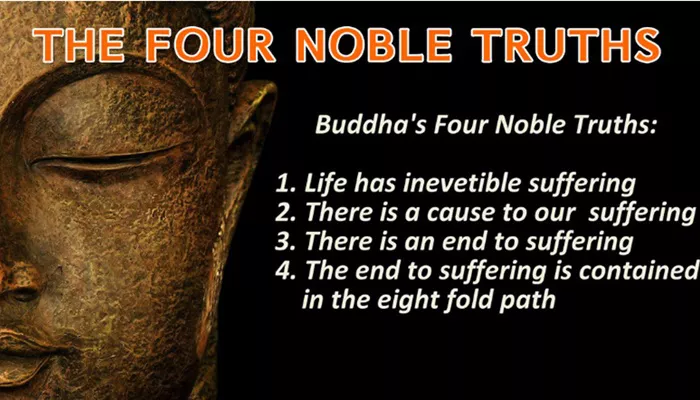The Four Noble Truths are the foundation of Buddhist teachings. They were taught by the Buddha after he attained enlightenment under the Bodhi tree. These truths explain the nature of suffering, its cause, its end, and the path to end it. If we want to understand Buddhism deeply, we must start here.
What Are the Four Noble Truths?
Before we explore where they are written, let’s briefly review what the Four Noble Truths are:
- The truth of suffering (dukkha)
- The truth of the cause of suffering (samudaya)
- The truth of the end of suffering (nirodha)
- The truth of the path that leads to the end of suffering (magga)
These truths form the first teaching the Buddha gave, which is called the Dhammacakkappavattana Sutta, or “Turning the Wheel of Dhamma.” This was given in a deer park in Sarnath, India.
Where Are the Four Noble Truths Written?
Early Buddhist Scriptures
The earliest and most trusted records of the Four Noble Truths are found in the Pali Canon. This is a collection of scriptures used by the Theravāda tradition of Buddhism. It is written in the Pali language and divided into three parts, known as the Tipiṭaka or “Three Baskets”:
- Vinaya Piṭaka – rules for monks and nuns
- Sutta Piṭaka – discourses of the Buddha
- Abhidhamma Piṭaka – philosophical and psychological teachings
The Four Noble Truths are first taught in the Dhammacakkappavattana Sutta, which is found in the Saṃyutta Nikāya of the Sutta Piṭaka. More precisely, it appears in SN 56.11. This is considered the Buddha’s first sermon after his enlightenment.
Dhammacakkappavattana Sutta (SN 56.11)
This sutta is part of the Saṃyutta Nikāya, which belongs to the Sutta Piṭaka. In this sutta, the Buddha explains the Four Noble Truths for the first time to five ascetics. This moment is important because it marks the beginning of the Buddha’s teaching journey.
The sutta lays out the structure of the Four Noble Truths clearly. The Buddha explains:
- Suffering is part of life.
- Desire and attachment cause suffering.
- It is possible to end suffering.
- The Eightfold Path is the way to do it.
Many versions of the Dhammacakkappavattana Sutta exist in other languages too, such as Sanskrit, Chinese, and Tibetan, used in other branches of Buddhism.
Other Places Where the Four Noble Truths Are Found
The Four Noble Truths are not only mentioned in SN 56.11. They appear again and again throughout the Buddhist scriptures. For example:
- Mahāsatipaṭṭhāna Sutta (DN 22) in the Dīgha Nikāya
- Saccavibhanga Sutta (MN 141) in the Majjhima Nikāya
- Various texts in the Chinese Āgamas and Tibetan Kangyur
Each version teaches the same core idea but may explain it with different examples or in different ways. This shows how important and central these truths are to all forms of Buddhism.
How the Four Noble Truths Were Passed Down
Oral Tradition Before Written Texts
For hundreds of years, the Buddha’s teachings were passed down orally. This was common in ancient India. Monks memorized the teachings and recited them often. This kept the teachings alive and accurate.
It wasn’t until around the 1st century BCE that the Pali Canon was written down in Sri Lanka. This was done to protect the teachings during times of war and famine. The Four Noble Truths, already well known and widely taught, were written into the texts as the core of the Buddha’s message.
Written Scriptures Across Traditions
Different Buddhist traditions wrote the teachings in different languages. For example:
- Theravāda Buddhism: Uses the Pali Canon.
- Mahayana Buddhism: Uses Sanskrit and Chinese sutras.
- Vajrayana Buddhism: Uses Tibetan translations and commentaries.
Despite the differences in language and tradition, the Four Noble Truths remain the same. They are respected and studied in every school of Buddhism.
Why the Four Noble Truths Matter
Central to the Buddhist Path
The Four Noble Truths are not just a part of Buddhism—they are the heart of it. Everything else in Buddhist practice—meditation, ethics, wisdom—grows from this foundation. They explain the problem of life and offer a way to solve it.
A Practical Guide
The truths are not meant to be believed blindly. The Buddha asked us to test them, understand them, and live by them. This is a personal path, not just a belief system. That’s why people still practice them today, more than 2,500 years later.
Examples of the Four Noble Truths in Daily Life
Recognizing Suffering
We all experience suffering. Whether it’s physical pain, sadness, or stress, it’s part of being human. The first truth helps us see this clearly, without running away from it.
Understanding the Cause
Often, our suffering comes from wanting things to be different—wanting more, or not wanting what we have. This craving creates stress and unhappiness.
Knowing Suffering Can End
This is a hopeful message. Suffering doesn’t have to control our lives. We can be free from it if we let go of craving and attachment.
Following the Path
The Eightfold Path shows us how to live wisely and peacefully. It includes right view, right speech, right action, and more. It’s a complete way to live a life of mindfulness and compassion.
Conclusion
The Four Noble Truths are written in many ancient texts, especially the Pali Canon. But more than being written, they are meant to be practiced. The Buddha did not want followers who only read his words—he wanted people to see the truth for themselves.
Whether you read them in the Dhammacakkappavattana Sutta or hear them from a teacher, the message is the same: suffering exists, it has a cause, it can end, and there is a way to end it. This is the path of wisdom and peace. It is the essence of four noble truths religion. May all who read these teachings take steps toward understanding and freedom.

